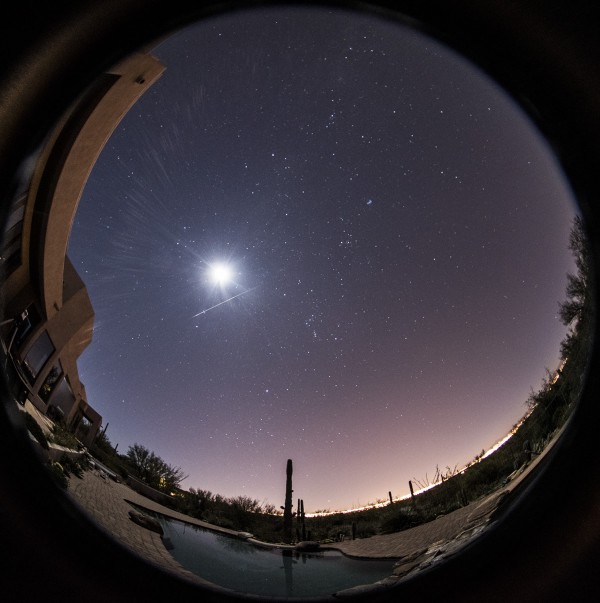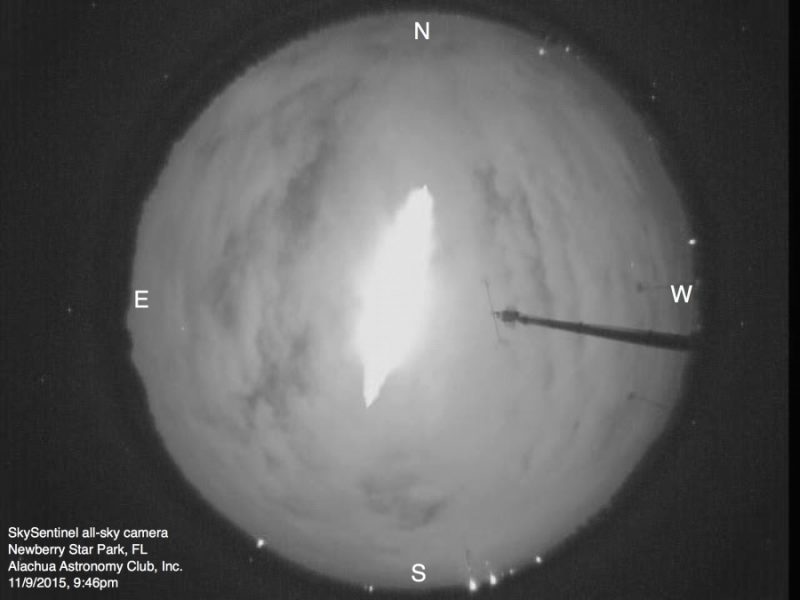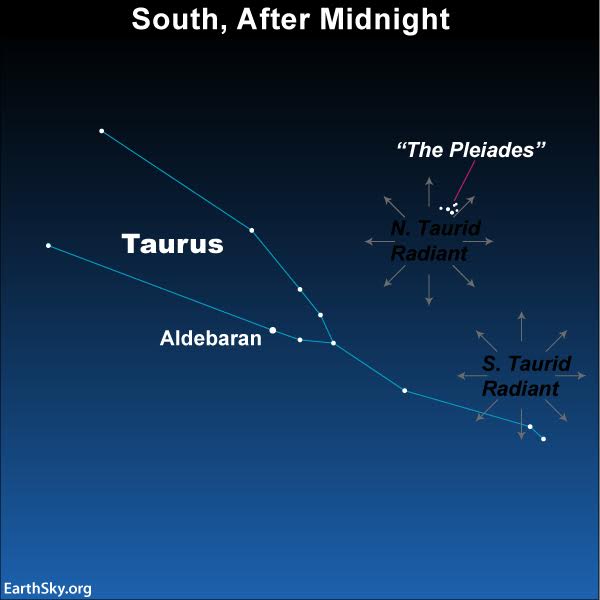
Taurid meteors in 2022: Lots of fireballs?
Taurid fireballs – visible in Earth’s skies in October and November – are often colorful. They often fragment as they streak slowly through the sky. In most years, only one percent of all Taurid meteors are fireballs. In exceptional years, when the Earth passes through a concentrated field of debris, the percentage can be as high as seven percent. So visual observers and astrophotographers might see several fireballs each night instead of the normal rate of one every 20 hours. In 2022, we have another opportunity to witness enhanced rates of fireballs during a two-week period. That period is centered on the peak date of November 5.
The last time the Earth encountered a concentration or swarm of Taurid meteors was in 2015. That year, rates for the South Taurids reached 10 per hour with numerous fireballs, such as the one pictured above.
Unfortunately, in 2022, a full moon occurs on November 8. So only a few hours of dark skies are available on the 5th. The moon will wash out most meteors on the days after the predicted peak. But, by their nature, fireballs are bright! They’re bright enough to shine through the moonlight.
The best observing time is before the full moon arrives on November 8. But, if you’re out on the morning of November 8 watching the total lunar eclipse, you might get lucky and spot some Taurid fireballs as well.
What are the Taurid meteors?
The South and North Taurid meteor showers are active every year throughout the months of October and November. They’re billed as a major annual meteor shower, but observers rarely see more than five meteors per hour. Astronomers studying the Taurids found that Earth encounters a concentration of larger-than-normal debris at intervals of three or seven years. Close conjunctions with the planet Jupiter cause this concentration. Interestingly, only the southern branch has this concentration of debris. Fireballs, or meteors that are larger and brighter than anything in the sky except the sun and moon, probably come from these larger particles.
The South Taurids run from about September 10 until November 20, peaking around November 4/5. The North Taurids overlap them, running from around October 20 to December 10, peaking around November 12/13.

The radiant of the Taurid meteor shower
The radiant of the South Taurids is located in western Taurus, south of the famous Pleiades star cluster. Due to the motion of the Earth around the sun, the radiant will drift eastward just under one degree each night and slightly northward. Therefore, if you are watching for Taurids in October, the radiant will be in the constellation Aries. Viewing after November 5, the radiant is slowly approaching the familiar V-shaped asterism of the Hyades in Taurus.
As seen from the Northern Hemisphere, the Taurid radiant lies above the horizon all night long. It’s highest near 2:00 a.m. local time. If observing during the evening hours, look eastward. Those viewing after 2 a.m. should face west. If the moon is in the sky, keep it out of your field of view to avoid ruining your night vision. The Taurid meteors are visible from most of the Southern Hemisphere but in lower numbers, because the radiant appears lower in the sky from places south of the equator.

Observers can submit number of meteors sighted
Serious observers are invited to count the number of meteors observed and submit them to the International Meteor Organization (IMO). This option is for registered members, but it’s free to those who just wish to contribute data. It creates an observing log you keep and add to after each meteor shower session. To produce scientifically useful data, please refer to information on visual observations. Plus, you’ll want to determine your viewing conditions.
You should view for at least one hour to get a true picture of the overall activity. Also, check here for more tips on viewing meteor showers. Meteors rarely appear at regular intervals but often appear in spurts with gaps of five to 10 minutes with no activity. We advise observers to use a comfortable lounge chair with a pillow and blanket. Being cold is no fun while out under the stars!
When are future swarms predicted?
The next predicted Taurid swarm is in 2025 and will most likely be weaker than 2022. That’s especially because a full moon occurs on the same night as maximum peak activity. Beyond that, 2032 appears to be an exceptional year, as the moon will be new and Earth will pass very close to the center of the swarm. Mark your calendar now!
The South Taurid meteoroid debris in space
Studying the Taurid meteors for large hidden asteroids
2/3 Several big asteroid surveys will conduct campaigns, however the asteroids should be accessible by larger amateur telescopes. If they are really there, some should have magnitudes of +19 and brighter. The best visibility period is between Oct 25 – Nov 5. pic.twitter.com/3znhkXumu2
— Denis Vida (@meteordoc) October 19, 2022
Was the 1908 Tunguska airburst a part of the Taurid complex? This campaign might help us find out. More info: https://t.co/K1R0bBOWro
— Denis Vida (@meteordoc) October 19, 2022
Bottom line: Take advantage of this opportunity to witness a possible increase in fireball activity of Taurid meteors. The South Taurids run from about September 10 until November 20, peaking around November 4/5.
Source: An observational synthesis of the Taurid meteor complex











